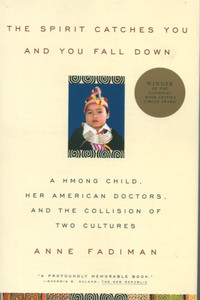Here is the publisher's description of the book:
Brilliantly reported and beautifully crafted, The Spirit Catches You and You Fall Down explores the clash between the Merced Community Medical Center in California and a refugee family from Laos over the care of Lia Lee, a Hmong child diagnosed with severe epilepsy. Lia's parents and her doctors both wanted what was best for Lia, but the lack of understanding between them led to tragedy. (From the publisher.)When three-month-old Lia Lee Arrived at the county hospital emergency room in Merced, California, a chain of events was set in motion from which neither she nor her parents nor her doctors would ever recover. Lia's parents, Foua and Nao Kao, were part of a large Hmong community in Merced, refugees from the CIA-run "Quiet War" in Laos. The Hmong, traditionally a close-knit and fiercely people, have been less amenable to assimilation than most immigrants, adhering steadfastly to the rituals and beliefs of their ancestors. Lia's pediatricians, Neil Ernst and his wife, Peggy Philip, cleaved just as strongly to another tradition: that of Western medicine. When Lia Lee Entered the American medical system, diagnosed as an epileptic, her story became a tragic case history of cultural miscommunication.
Parents and doctors both wanted the best for Lia, but their ideas about the causes of her illness and its treatment could hardly have been more different. The Hmong see illness and healing as spiritual matters linked to virtually everything in the universe, while medical community marks a division between body and soul, and concerns itself almost exclusively with the former. Lia's doctors ascribed her seizures to the misfiring of her cerebral neurons; her parents called her illness, qaug dab peg—the spirit catches you and you fall down—and ascribed it to the wandering of her soul. The doctors prescribed anticonvulsants; her parents preferred animal sacrifices. (Also from the publisher.)
Before I get into the discussion, I want to share my opinion on this book. This was an amazing book. Not only is it well written and engaging, but it taught me so much about history and issues I knew nothing about. This is going to become one of my go-to sure bets to hand out to patrons looking for a good read when it joins our book discussion collection next month.
Now on to the discussion:
- You know the drill with us. We had 9 likes, 2 so-sos and 1 dislike. The dislike was more because she was so angry about how the 2 cultures clashed and could not see eye to eye. The little girl who suffered at the center of the tale was too much for her to finish. But she liked the Hmong history part.
- Here are some of the initial likes comments:
- I thought all immigrants came to America because they wanted to, but after reading about the Hmong, my eyes have been opened to that fact that this is not always the case.
- I liked learning about the history of the Hmong. I knew nothing about them before this.
- I enjoyed the structure of the book. (more about this later)
- The collision of cultures-- how there was total misunderstanding by well meaning parties on both sides that caused so many problems-- was enlightening.
- It was hard to relive the anger from the Vietnam era and how badly our country screwed it up, but I was glad to see the contributions of the Hmong people working for the CIA acknowledged.
- This book gave me insight into myself as a reader. I need my history to be personal. I am reading a Lincoln biography right now which is good, but it did not capture me like Fadiman's book did.
- I asked about the structure of the book; how Fadiman chose to relate this complex story. Just Lia's medical story is hard enough, but then to have to also explain thousands of years of Hmong history and culture is quite a feat. I described the structure this way: the book is told with Lia's story as a winding river running through the center of the book, with the story spilling over onto the banks and at times trekking far inland; but always it is the river of Lia's story that anchors the work.
- This left us to talking about all of the history packed into the book. It reminded many of us of other incidents in our country when we wanted to do right but still screwed up. One person said the Hmong were very similar to the Native Americans: no written language, story telling tradition, and we came in and assumed that meant they were stupid. We took away their way of life and they can never have it back.
- We were amazed by how the Hmong kept their culture together for thousands of years without a homeland or written language by using storytelling, rituals, and a detailed family/clan hierarchy.
- We spent a lot of time talking about the failures of medicine. We need to remember this was a book written about the 1980s. Medicine has changed a lot since then, and now doctors are encouraged to be more culturally sensitive. Here is some of our conversation about the medical aspects of the book:
- Although the lack of sensitivity was a factor in Lia's seizure disorder care, "the big one," the seizure that left her in a vegetative state, was brought on by an underlying infection that no one noticed. Lia had become her disease and the doctors could not see past the seizures.
- Medicine in the 1980s was very disease focused. Doctors did not look at the whole patient, just the disease. Now things have changed and doctors are trained to use the best of Eastern and Western medicine to treat the person.
- Drs. Peggy and Neil wanted to give Lia lots of medicines because that is what they would have done for an American family, but the Hmong family who have no experience with letters and numbers had a lot of trouble keeping the medicines and dosages straight. One medicine would have worked okay and been more reliably given, but Peggy and Neil felt that that would be giving a lower standard of care. They couldn't consider the cultural differences.
- Neil reported Lia's parents to Child Services because he thought her life was in danger since the parents were not giving the medicine correctly. Everyone was lucky that Lia's short stay in a foster home was with such a great family.
- On pages 260-261 (end of chapter 17, "The Eight Questions,") Fadiman talks about the work of Arthur Kleinman in creating a list of 8 cross-cultural medical questions:
1. What do you call the problem?2. What do you think has caused the problem?3. Why do you think it started?4. What do you think the sickness does? How does it work?5. How severe is the sickness? Will it have a short or long course?6. What kind of treatment do you think the patient should receive? What are the most important results you hope she receives from this treatment?7. What are the chief problems the sickness has caused?8. What do you fear most about the sickness?
- Fadiman gave this questionnaire to the Lee's after Lia was in a vegetative state. We could all easily see where things went wrong just from the answers, but what was shocking to us, was that after years of treating Lia, when Peggy and Neil saw their answers to these questions, they had no idea how the Lee's had felt. We talked about how every doctor should ask these questions to every patient, every time.
- We went back to talking about the Hmong culture some more. I asked the group what they thought the most important aspect of their culture was:
- the fish soup story of their history-- really storytelling in general. We also talked about how the fish soup story the Hmong people tell as their origin story is also a model for how the book is told.
- love of family
- spirituality in everything
- perseverance
- rituals
- independence
- "collaborative self-reliance"-- on participant coined this phrase to describe how the Hmong took care of themselves as a group.
- I ended the discussion by asking everyone to share what they "got out of" this book. Here are the responses:
- It was tragic and sad, but it showed me that in any tragic situation, there are failures on both sides.
- I liked how the author did not take sides; she simply presented the full picture
- Sometimes there is no bad guy, there is only the truth.
- Everybody has a story to tell
- I learned a reverence for the Hmong culture
- I am grateful that the author stuck with the story after it fell through as a magazine article to turn it into a book. We have all learned because she wrote it.
- People who mean well and want to do good often do very weird things in pursuit of a good goal.










No comments:
Post a Comment